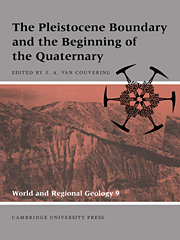Book contents
- Frontmatter
- Contents
- List of contributors
- Preface: the new Pleistocene
- Foreword
- Part I Definition of the base of the Quaternary
- Part II Characterization of the Pleistocene boundary-stratotype
- Part III The paleontological context of the Pleistocene boundary
- 7 The Pliocene–Pleistocene boundary in deep-sea sediments
- 8 Late Cenozoic changes of flora in extra-tropical Eurasia in the light of paleomagnetic stratigraphy
- 9 Plio–Pleistocene mammal faunas: an overview
- 10 Human evolution in the Plio–Pleistocene interval
- Part IV The Pleistocene boundary in regional sequences
- Index
9 - Plio–Pleistocene mammal faunas: an overview
Published online by Cambridge University Press: 10 November 2009
- Frontmatter
- Contents
- List of contributors
- Preface: the new Pleistocene
- Foreword
- Part I Definition of the base of the Quaternary
- Part II Characterization of the Pleistocene boundary-stratotype
- Part III The paleontological context of the Pleistocene boundary
- 7 The Pliocene–Pleistocene boundary in deep-sea sediments
- 8 Late Cenozoic changes of flora in extra-tropical Eurasia in the light of paleomagnetic stratigraphy
- 9 Plio–Pleistocene mammal faunas: an overview
- 10 Human evolution in the Plio–Pleistocene interval
- Part IV The Pleistocene boundary in regional sequences
- Index
Summary
Introduction
The evidence from mammalian biostratigraphy with regard to the boundary between the Neogene and the Quaternary, or, more precisely, the base of the Pleistocene, can be analyzed in various ways. Long-established regional biostratigraphic scales are still widely used, although for the most part they are based on uneven, inadequate evidence and thus are subject to differing and unreliable interpretations. In seeking for greater reliability, vertebrate paleontologists in the past few decades have attempted to subdivide the geological time scale into probabilistic mammal ages and mammal zones, such as the MN (Mammal Neogene) zones of Mein. That approach is equally subject to imprecision and subjective bias (De Bruijn et al., 1992; Fahlbusch, 1991), and scholars may, consciously or unconsciously, constrain the paleofaunal changes to coincide with a particular magnetic reversal, a climate event, or any other significant, even preselected, level.
The objective approach is to begin with the ages of local faunal horizons that are directly based on radiometric dates or paleomagnetic analysis and build a biochronologic framework on this ground (e.g., Lindsay et al., 1987). Interpolations are legitimate, as are correlations based on faunal similarities, when the limits of probable error are realistically included. In cases where a local fauna presents many first appearances or last appearances, it is reasonable to suspect a lack of information in the preceding or following time interval, respectively. When the sampling factor is corrected, if unusual numbers of earliest and latest occurrences are still seen at one level, a genuine faunal overturn can be inferred.
- Type
- Chapter
- Information
- The Pleistocene Boundary and the Beginning of the Quaternary , pp. 114 - 128Publisher: Cambridge University PressPrint publication year: 1996
- 1
- Cited by



